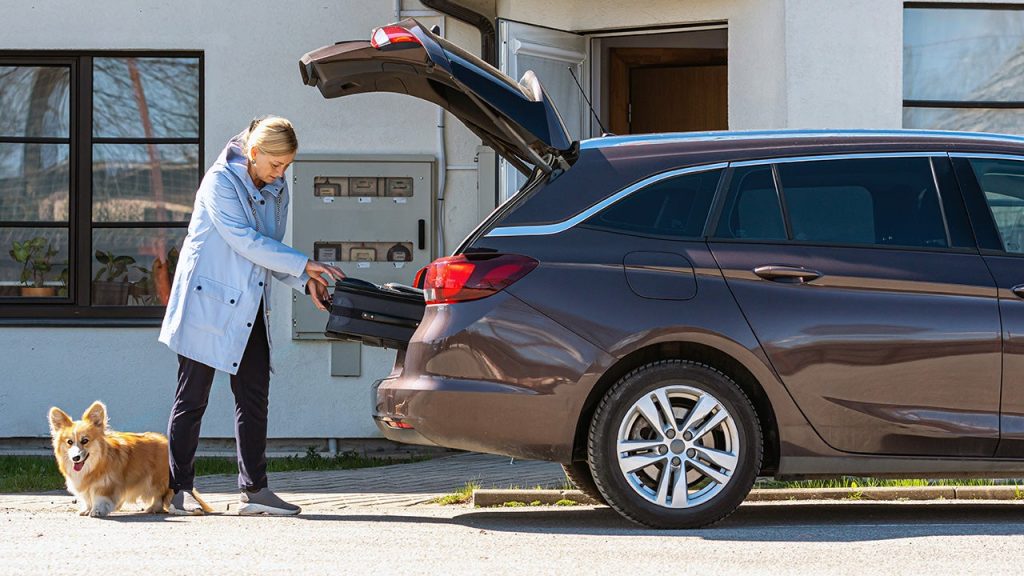If you’re an existing or prospective Allstate auto insurance policyholder, you may have been asked to enroll in Allstate’s Drivewise program for potential premium savings. This telematics program monitors your driving in real time, noting behaviors such as hard braking and speeding, and rewards drivers who prove themselves to be safe and careful behind the wheel. The program is available in all states except California and Alaska, and may help some drivers save money on their coverage.
What is Allstate Drivewise?
Allstate’s Drivewise program is a telematics program that leverages mobile technology to help drivers potentially reduce their insurance costs through safer driving. As of November 13, 2023, the program has transitioned fully to mobile app usage, moving away from the plug-in devices previously used. Participants simply download the Allstate mobile app, which then monitors their driving behavior directly through their smartphones.
This shift enhances user convenience and accessibility, allowing the program to provide real-time feedback on driving habits. By engaging with this feedback, drivers can improve their safety on the road and may qualify for discounts on their insurance premiums based on their driving performance.
News
Businesswire reported in April 2024 that recently released data indicates Allstate customers who chose to opt into their telematics driver safety app, Drivewise, were found to be 25 percent less likely to be involved in a serious collision. Ginger Purgatorio, executive vice president at Allstate, stated, “We find that when customers choose to use Drivewise on their Allstate mobile app, they tend to drive safer. And those who drive safer not only get in fewer accidents but also can save money on their auto insurance.”
What does Allstate Drivewise track?
Allstate Drivewise leverages advanced mobile technology to monitor and reward safe driving habits. By downloading the Allstate mobile app and activating Drivewise, users allow the app to collect a variety of driving data, which plays a crucial role in determining potential savings on insurance premiums. Below is a detailed breakdown of the data collected by Drivewise, with certain metrics that specifically influence savings noted with an asterisk (*).
Trip report data:
- Timestamps: Recorded at the start and end of each trip, including when the trip data is uploaded.
- Location: Start and end locations (latitude and longitude).
- Speed: Average speed while in motion, maximum speed during the trip and miles driven above 80 mph*.
- Duration and Distance: Total distance covered and the duration of the trip.
- Idle Time: Time spent with the vehicle running but not in motion.
Driving behaviors:
- Braking and acceleration events: The app counts occurrences of braking and accelerating in specific speed change bands and identifies extreme cases of each.
- Hard braking events* are classified as reductions in speed of 8 to 10 mph within one second.
- Extreme braking events* involve slowing down by more than 10 mph within the same timeframe.
- High-speed events: Each instance where the vehicle exceeds 80 mph is recorded*.
- Time ranges: Miles driven during different times of day, which may impact risk assessment*.
Additional data collected:
- Event details: Includes type, duration, start and end specifics, speed changes and method of detection for each recorded event.
- GPS trail: Analyzed every second and persisted every 30 meters to include time, position, speed and accuracy.
- System and device information: Including mobile software version, type of mobile device and the version of the Allstate mobile app used during the trip.
- Trip termination: Reasons for ending a trip, such as low battery or app closure.
- Trip rejection: Reasons why a trip might be excluded from the driving history, such as illogical data from non-driving activities.
By actively monitoring these parameters, Drivewise not only helps promote safer driving but also provides personalized feedback and potential rewards through premium discounts. This data-driven approach aims to align financial incentives with safe driving behavior, benefiting both the insurer and the insured.
How to enroll in Allstate Drivewise
To get started with Drivewise, download the Allstate mobile app onto your smartphone and create an account at AllstateRewards.com. Note that the rewards drivers can earn may vary according to state regulations. For instance, Drivewise savings are not available in California and Alaska. Contact a local Allstate agent for details about the Drivewise program in your area.
What requirements are needed to use Allstate Drivewise?
To ensure that Allstate Drivewise functions correctly and can accurately track your driving habits, there are several requirements you must meet:
- Location services: Location detection must always be turned on. The app uses this data to automatically detect when a trip starts and ends. Without location services enabled, the app cannot collect trip information or provide personalized feedback, which may impact your potential savings.
- Battery power: Your mobile phone should have at least 5 percent battery power to ensure that the app can function throughout your trips. If your phone powers down during a trip due to low battery, the trip may not be recorded.
- App settings on iOS: You should allow “Motion and Fitness” access and set your location access to ‘Always’ with ‘Precise Location’ enabled to allow the app to monitor your trips effectively.
- App settings on Android: It’s necessary to allow “Physical Activity,” set your location access to “Always,” and ensure that ‘Power Saving Mode’ is turned off. For devices running Android OS 12, confirm that ‘Precise Location’ is set to “On.”
- Minimum travel speed: The app is designed to start recording a trip when your vehicle travels at least 15 mph for a minimum of one minute, such as a drive from home to your local supermarket.
By meeting these requirements, you enable Drivewise to collect detailed information about your driving patterns, potentially leading to savings on your insurance premiums through safer driving practices.
Who should use Allstate Drivewise?
Drivers who have Allstate may want to consider the Drivewise program if they are committed to driving safely, intend to stick with Allstate and want to earn a discounted car insurance premium. However, similar to Progressive Snapshot, which also uses telematics, it’s possible that repeated high-risk driving behavior could lead to more expensive insurance rates.
Drivewise is a great option for drivers who maintain the proper speed limit, drive primarily during daylight hours and avoid extreme or sudden braking. And for teens learning to drive, Drivewise can be a helpful tool for parents to use the trip data to see how well their kids perform behind the wheel.
How much can I save with Allstate Drivewise?
Allstate doesn’t state exactly how much money drivers could save through the Drivewise program. The total premium savings linked to Drivewise will be contingent on the customer’s driving habits. However, the company does say that drivers receive a participation discount for signing up for the program, and if at least 50 trips are taken prior to renewal, their participation discount will remain.
Pros and cons of Allstate Drivewise
Allstate Drivewise may help some drivers save on their premium, but the program isn’t right for everyone. Below are some of the key perks and common Allstate Drivewise complaints:
Pros of Allstate Drivewise
- Mobile app integration: Drivers can access their insurance card, policy information and Drivewise account all in one place
- Insight into driver behaviors: This includes real-time alerts and a summary of driving habits over time.
- App tracks when drivers reach for the phone: This can increase awareness and lead to safer driving habits.
- Crash detection: If the app registers an accident, it can help drivers get claim help, call emergency services or contact roadside assistance.
- Discounts: Drivers get a participation discount and the potential to see an overall premium reduction depending on driving behaviors.
Cons of Allstate Drivewise
- Braking limitations: Drivers in large cities or areas with heavy traffic may need to brake frequently, which the app discourages.
- Speed limitations: Some highways may allow speeds at or above 80 miles per hour, which is perceived negatively for Drivewise purposes.
- May not benefit infrequent drivers: Those who do limited driving or work from home may see more savings with usage-based car insurance.
- Data privacy may be a concern: Allstate agents and customer service representatives can see driver data gathered by Drivewise.
- Premium may increase: Allstate notes that drivers who have riskier driving behaviors may see their premiums increase as a result.
Even if Drivewise is not the right fit for you, it’s typically smart to do some comparison shopping and obtain multiple car insurance quotes. This will help you get a feel for average insurance rates in your area and what insurance company is right for you.
Comparing Allstate Drivewise to other telematics programs
Telematics programs have become a popular way for drivers to potentially reduce their auto insurance premiums by demonstrating safe driving habits. Allstate Drivewise is just one of several options available, each with its own set of features and potential benefits. Let’s compare Drivewise to other major telematics programs from some of the biggest names in the insurance industry.
- State Farm Drive Safe and Save: This program uses telematics to monitor driving behavior and offers discounts for safe driving. It does not state that rates could increase based on the data collected.
- Progressive Snapshot: One of the more well-known programs, Snapshot can adjust rates based on driving behavior. Notably, unlike some other programs, Progressive may increase your rates if the data suggests risky driving behaviors.
- USAA SafePilot: Specifically designed for USAA members, SafePilot rewards drivers for safe driving habits. This program focuses heavily on reducing distracted driving and encourages safer speeds.
- Geico DriveEasy: Geico’s program also monitors driving habits and could lead to discounts for safe driving. However, DriveEasy may result in higher rates if risky behaviors are detected during the monitoring period.
Each of these programs uses a mobile app to collect data on driving habits such as speed, braking and time of driving, which can influence insurance rates. However, the specifics of how much you can save and the exact metrics monitored can vary from one program to another.
As you are conducting your Allstate Drivewise review and considering which telematics program might be right for you, it can also be useful to look at how users rate these apps and how they are scored by industry standards, such as the J.D. Power U.S. Insurance Digital Experience Study, which gauges customer satisfaction with various insurers mobile applications. The table below provides a comparison of app ratings and J.D. Power scores.
| Allstate Drivewise | 4.8/5.0 | 3.9/5.0 | 713/1,000 |
| State Farm Drive Safe and Save | 4.6/5.0 | 4.0/5.0 | 703/1,000 |
| Progressive Snapshot | 4.4/5.0 | 3.6/5.0 | 737/1,000 |
| USAA SafePilot | 4.5/5.0 | 4.2/5.0 | 743/1,000 |
| Geico DriveEasy | 3.6/5.0 | 3.6/5.0 | 668/1,000 |
Frequently asked questions
-
With Allstate Drivewise, it’s advisable to keep your driving speed below 80 mph to maintain eligibility for potential insurance discounts. The program is designed to promote safe driving habits and typically marks speeds above this threshold as unsafe. Importantly, Drivewise does not compare your speed against the speed limit of the zone you are in; therefore, exceeding the speed limit in a lower-speed area without surpassing 80 mph generally won’t impact your discount eligibility.
-
Drivewise is linked to the person, not the vehicle. This means the program can detect when you are a passenger rather than the driver. If Drivewise incorrectly records you as the driver during trips where you were actually a passenger, you can easily update this information in the Allstate mobile app. To make this correction, log in to the app, go to the Drivewise dashboard, view all trips under ‘My Trips,’ select the trip in question and update your status in the trip method to reflect that you were not the driver.
-
The Crash Detection feature in the Allstate mobile app is a safety tool designed to detect significant collisions. If the app senses a major impact while the vehicle is traveling at a speed of at least 25 mph, it will send a notification through the app to offer assistance. However, it’s important to note that this feature is not designed to detect minor collisions, such as fender-benders or situations where you might be rear-ended.
-
Whether Drivewise is a good option for you depends on several factors. Perhaps most importantly is your driving ability. If you are generally a safe and careful driver, specifically in relation to the factors Drivewise considers, you may benefit from the program’s monitoring. If you struggle to engage in safe behaviors behind the wheel, on the other hand, using this telematics program could even lead to an increase in your premium. Some people may be safe drivers, but have lifestyles that are not well aligned with Drivewise participation. If you frequently drive at night, take long road trips, or live in an area with lots of traffic or high speed limits, you may want to discuss these factors with your agent before enrolling.
-
In our Allstate Drivewise review, we found that Drivewise and Milewise cater to different needs. Drivewise is a program that monitors your driving habits and may offer discounts based on safe driving, while Milewise is a pay-per-mile insurance option ideal for those who drive less. With Milewise, you pay a base daily rate plus a rate per mile driven, which can be a cost-effective choice for people who don’t use their car frequently, such as stay-at-home parents, retirees or those who primarily work from home.
Read the full article here
















